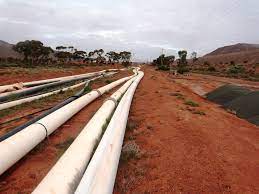
*Representational image credit Wikipedia
The 'Urja Ganga' pipeline, India's most ambitious project taking environment-friendly gas to so-far untouched areas, has taken the benefit of lower natural gas prices to the hinterland, helping expand adoption of the cleaner fuel,it is learnt.
Traditionally, natural gas was available for use as fuel to generate electricity, make fertilizer or turn into CNG and cooking gas was available only in the Western and Northern parts of the country, as pipelines taking the fuel from source to users were limited to these parts.
In October 2016, work on laying a 2,655-km pipeline from Jagdishpur in Uttar Pradesh to Haldia in West Bengal, Bokaro in Jharkhand and Dhamra in Odisha began.
The line was extended to Guwahati in Assam from Barauni in Bihar, a length of 726 km, to take the fuel to hereto- unconnected states in the East.
The Jagdishpur-Haldia -Bokaro-Dhamra Pipeline (JHBDPL), popularly called the Pradhan Mantri Urja Ganga pipeline, is now ready to supply gas to the eastern states of Bihar, Jharkhand, Odisha and West Bengal, official sources said.
This has helped pass on the benefit of reduction in CNG and piped cooking gas prices to consumers in these regions following the government's decision to cut input natural gas prices.
About Rs 5-7 reduction in rates has now reached consumers in 20 towns and cities in the hinterland.
The gas pipeline is the cheapest mode of transportation of gas.
Investigation gathered information indicating that just to carry gas to the eastern states of India, state-owned gas utility GAIL (India) Ltd was authorized to lay JHBDPL. The government provided 40 per cent viability gap funding amounting to Rs 5,176 crore for the execution of JHBDPL.
Further, as a part of JHBDPL, GAIL is also laying Barauni-Guwahati pipeline which shall act as a source for North East Gas Grid pipeline being executed with 60 per cent viability gap funding amounting to Rs 5,559 crore to connect all the North Eastern states to natural gas source and supply gas to all parts of the country.
The Pradhan Mantri Urja Ganga pipeline will connect all the geographical areas (more than 90) spread over the states of Uttar Pradesh, Bihar, Orissa, West Bengal and further to the North Eastern Region of India.
With the completion of this project, the North Eastern/ Eastern part of India becomes an integral part of the gas-based economy with twin benefits of the cheapest transportation of gas through Urja Ganga and gas pricing reforms, investigation revealed.
Under the unified tariff regulations recently notified by sector regulator Petroleum and Natural Gas Regulatory Board (PNGRB), transportation tariff has been cut by about 50 per cent to Rs 99.90 per million British thermal units for the eastern parts, helping make the clean fuel more affordable.
Last week, the Cabinet Committee on Economic Affairs approved the revised domestic natural gas pricing guidelines for gas produced from nomination fields of state-owned Oil and Natural Gas Corporation (ONGC) and Oil India Ltd.
The price of such natural gas shall be 10 per cent of the monthly average of Indian crude basket and shall be notified on a monthly basis. The price for gas produced from nomination fields of ONGC/OIL shall have a floor and a ceiling. This has resulted in reduction of gas price from USD 8.57 per mmBtu to USD 6.5 per mmBtu.
The reforms will lead to significant decrease in prices of piped cooking gas for households and compressed natural gas (CNG) for transport, concerned officials said adding the reduced prices shall also lower the fertilizer subsidy burden and help the domestic power sector.